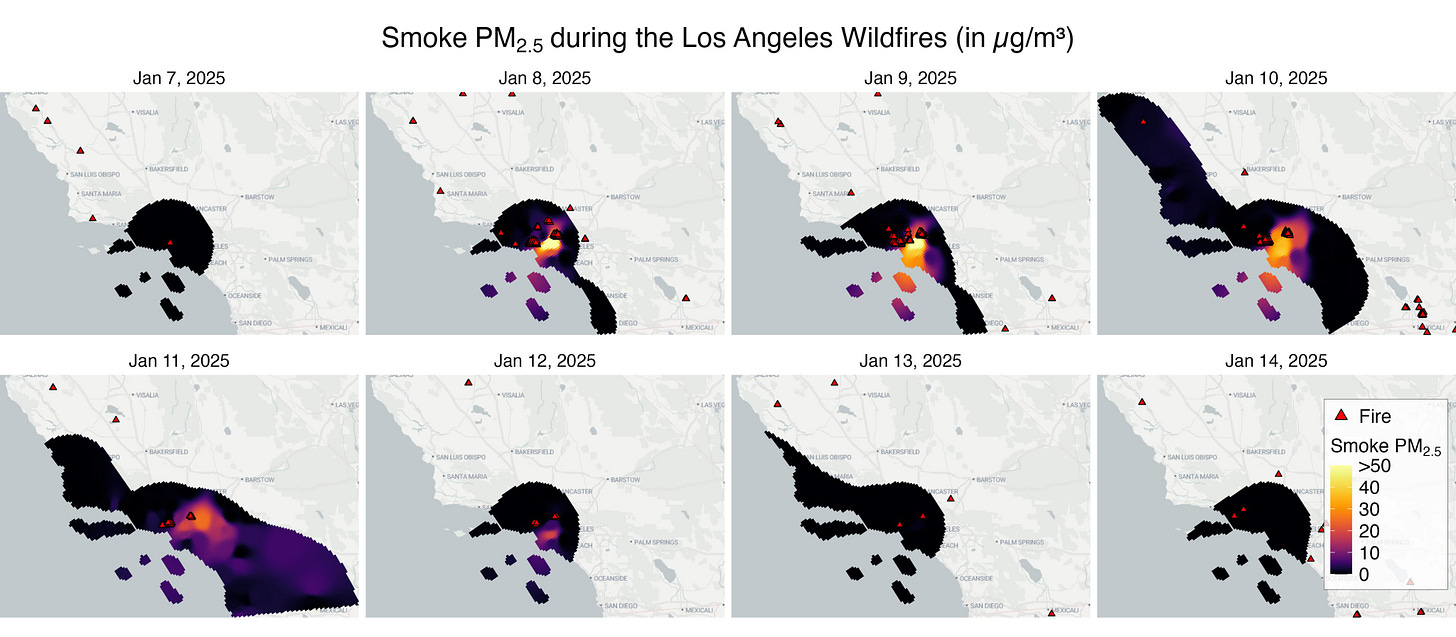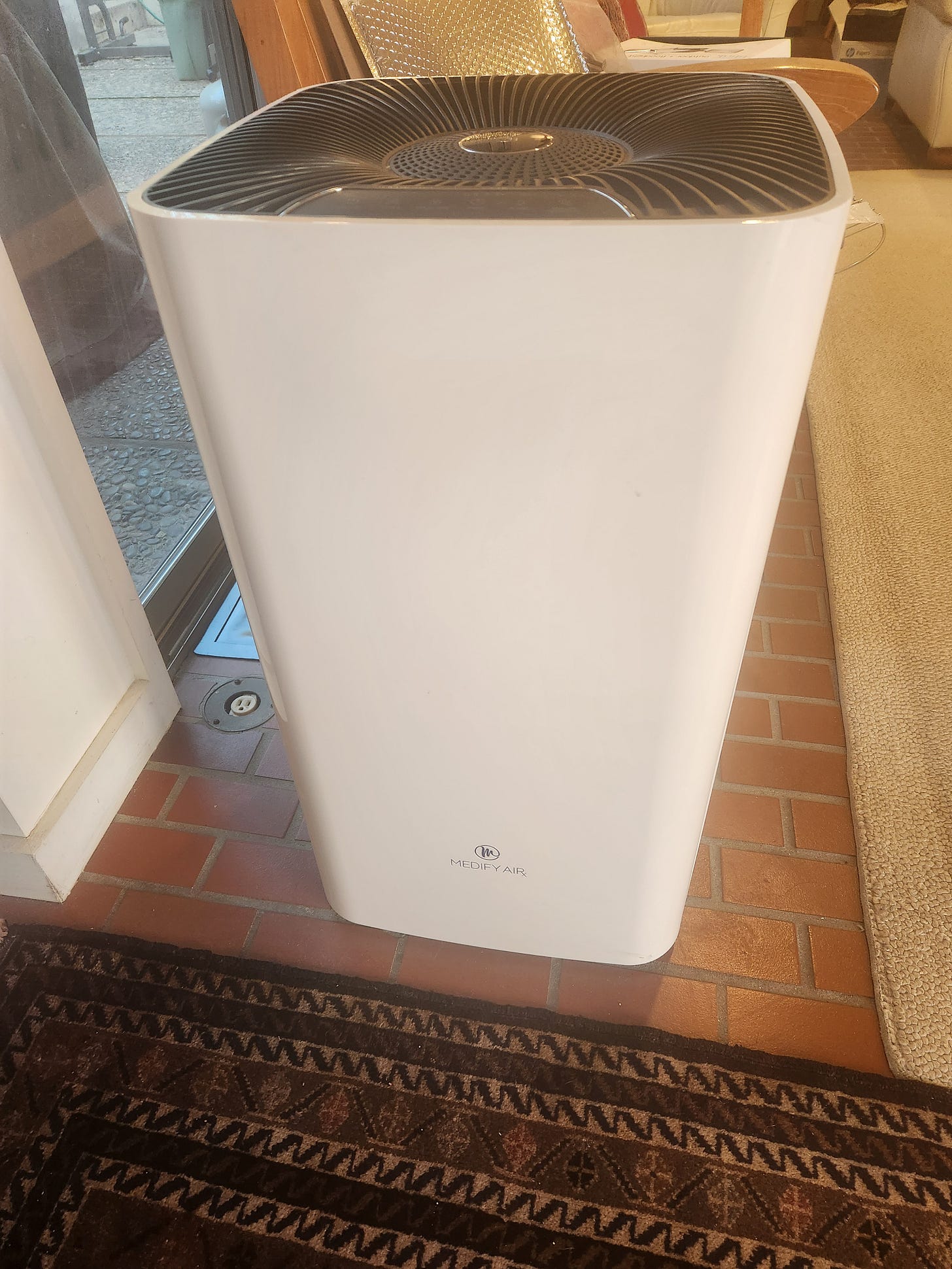On most days, the quality of life in West Los Angeles is great. Most days are neither too hot nor too cold. There is little humidity, the sky is blue, and the air quality is quite good. During the January 2025 LA Fires, the local air quality was terrible. The air smelled the same as when I was in New Delhi, India.
A “silver lining” of the horrible Fires is that it offers academics an experiment to study whether more people adapt to pollution shocks. Marshall Burke and his research team at Stanford University have made great maps documenting the spatial spike in PM2.5 in the Los Angeles region in the aftermath of the LA Fires. Marshall tweets about his findings here.
This first set of his figures shows the eight-day spatial map of elevated PM2.5 levels across Los Angeles.
Marshall overlays the number of people exposed to the pollution spikes in this second figure and creates this great graph. The way to read this graph is that on January 10th, 2025, roughly 2.5 million people in the LA area were exposed to at least 35 units of PM2.5 smoke, and approximately 6 million were exposed to at least 25 units of PM2.5 smoke.
In this post, I want to discuss what the words “exposed to” mean. Marshall is measuring the outdoor level of air pollution in places where people live.
People are not soil! How did we adapt during the crisis?
Dora and I spent more time inside our Westwood house, close to UCLA. We monitored air pollution on an almost hourly basis, both using Google and our home PM2.5 air pollution monitor. This $150 device always sits in our living room. During the January 2025 pollution spike, we ran this device 24 hours a day. It cleaned our air.
When we went outside during the bad air days, Dora wore a protective N-95 Mask. I claim that our exposure to harmful air was minimal. We took steps to protect ourselves.
Of course, we are privileged professors. How many other people in LA took these steps to reduce their PM2.5 exposure? What steps did they take? Wealthy people flew away to their 2nd homes in different places. What did poor people do all day long during the Wildfire shock?
Each of us had strong incentives to take protective actions, but we differed regarding the family-specific menu options we had.
The empirical test of whether the LA people successfully adapted is whether the resulting short-term and long-term morbidity and mortality damage is small.
Marshall Burke and his co-authors have shown how past pollution spikes have impacted local mortality and morbidity rates. Here is his high-quality PNAS paper, which uses data from 2006 to 2017.
I view this type of high-quality empirical work as providing a history lesson. It teaches us what health damage we suffered when we were exposed to air pollution in the past. I do not view such estimates as offering a credible prediction tool for extrapolating the health damage caused by the 2025 LA Fires.
Climate Data Scientists engage in the following extrapolation exercise.
Step #1 They use historical data to estimate a past correlation between pollution and health risks. For example, see the findings posted here.
Step #2 They present a new climate shock scenario, similar to the facts I presented above, that during the LA Fires, roughly 6 million people were exposed to at least 25 units of PM2.5 smoke.
Step #3 They combine Step #1 and Step #2 to predict the damage caused by the new shock.
This approach implicitly embraces the strong assumption that we do not ADAPT over time to emerging risks. They implicitly assume that Step #1 is a “law of physics” such that past correlations will be future correlations, as people are passive victims who do not invest in protecting themselves and their families from anticipated risks. I reject this assumption, and my research focuses on why I am much more optimistic about how our economy shifts over time to protect us from emerging, anticipated risks.
Think of the air filter that Dora and I own. We didn’t own it back in 2016. We bought it because we fear PM2.5 spikes in our area. More and more of us fear these spikes and are proactively investing in such devices to protect ourselves. This is active adaptation. As more of us seek out solutions to these anticipated challenges, for-profit firms step up and innovate to improve the quality of these products. Think of your cell phone and how its price per quality unit has declined. The same dynamic will play out regarding adaptation products. Most poor people own cell phones today. People experiencing poverty have less access to adaptation strategies, creating an imperative to reduce poverty.
What about outdoor workers? How do we protect them from heat and pollution exposure? Is more workplace regulation the right way to protect them? Joe Tracy and I answer “no” in this piece.
The interesting economics question relates to how we use markets to unleash adaptation innovation. I explore this question in my 2021 book, Adapting to Climate Change.
Let me wrap up by citing an article in the LA Times today. Here is my tweet about it.
We want to be safe and comfortable and raise kids who flourish. Crazy weather where we live poses threats to all three. The LA Region is home to over 10 million people. If 1 out of every 1000 people suffered from the shock, then there would be 10,000 people who suffered from the shock. If 1 out of every 100 people suffered, then there would be 100,000 total victims.
As we better understand pollution exposure risks to our health and quality of life, we seek private sector solutions, and firms compete to sell us such solutions. This messy, dynamic process protects us and the damage caused by future shocks declines. This logic forms the basis for rejecting the idea that we can use past correlations between pollution shocks and health damage to predict our future. Every day, we become better at adapting to emerging risks when we allow markets to function and signal the new risks and opportunities we face.









Matthew, nice piece. One additional point you can make is that 'correlation does not imply causation' and the identification of causation in any context is a non-trivial matter